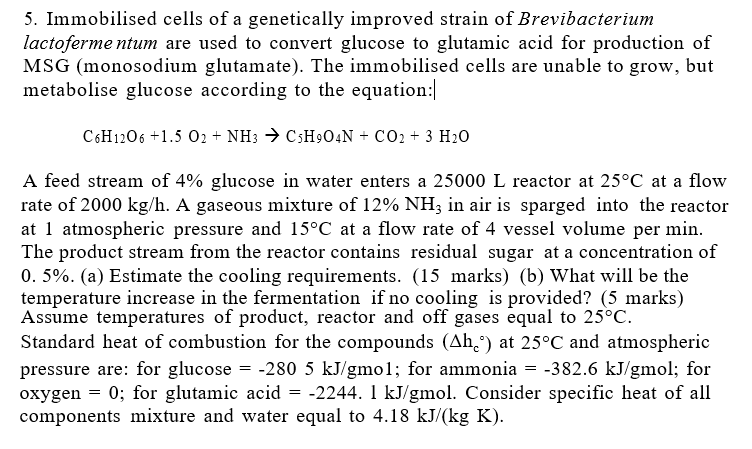Home /
Expert Answers /
Chemical Engineering /
5-immobilised-cells-of-a-genetically-improved-strain-of-brevibacterium-lactofermentum-are-used-to-pa832
(Solved): 5. Immobilised cells of a genetically improved strain of Brevibacterium lactofermentum are used to ...
5. Immobilised cells of a genetically improved strain of Brevibacterium lactofermentum are used to convert glucose to glutamic acid for production of MSG (monosodium glutamate). The immobilised cells are unable to grow, but metabolise glucose according to the equation: A feed stream of glucose in water enters a reactor at at a flow rate of . A gaseous mixture of in air is sparged into the reactor at 1 atmospheric pressure and at a flow rate of 4 vessel volume per min. The product stream from the reactor contains residual sugar at a concentration of . (a) Estimate the cooling requirements. (15 marks) (b) What will be the temperature increase in the fermentation if no cooling is provided? (5 marks) Assume temperatures of product, reactor and off gases equal to . Standard heat of combustion for the compounds at and atmospheric pressure are: for glucose ; for ammonia ; for oxygen ; for glutamic acid . Consider specific heat of all components mixture and water equal to .
Expert Answer
(a) To estimate the cooling requirements, we need to determine the rate of heat generation in the reactor due to the fermentation process. The heat generated per unit time can be calculated from the rate of glucose consumption, which can be determined as follows:The feed stream contains 4% glucose in water, which means that the flow rate of glucose into the reactor is: Assuming that all the glucose is consumed by the immobilized cells, the rate of glucose consumption is also 80 kg/h.From the balanced chemical equation for the fermentation, we can see that one mole of glucose is converted to one mole of glutamic acid, which means that the rate of glutamic acid production is also 80 kg/h.
